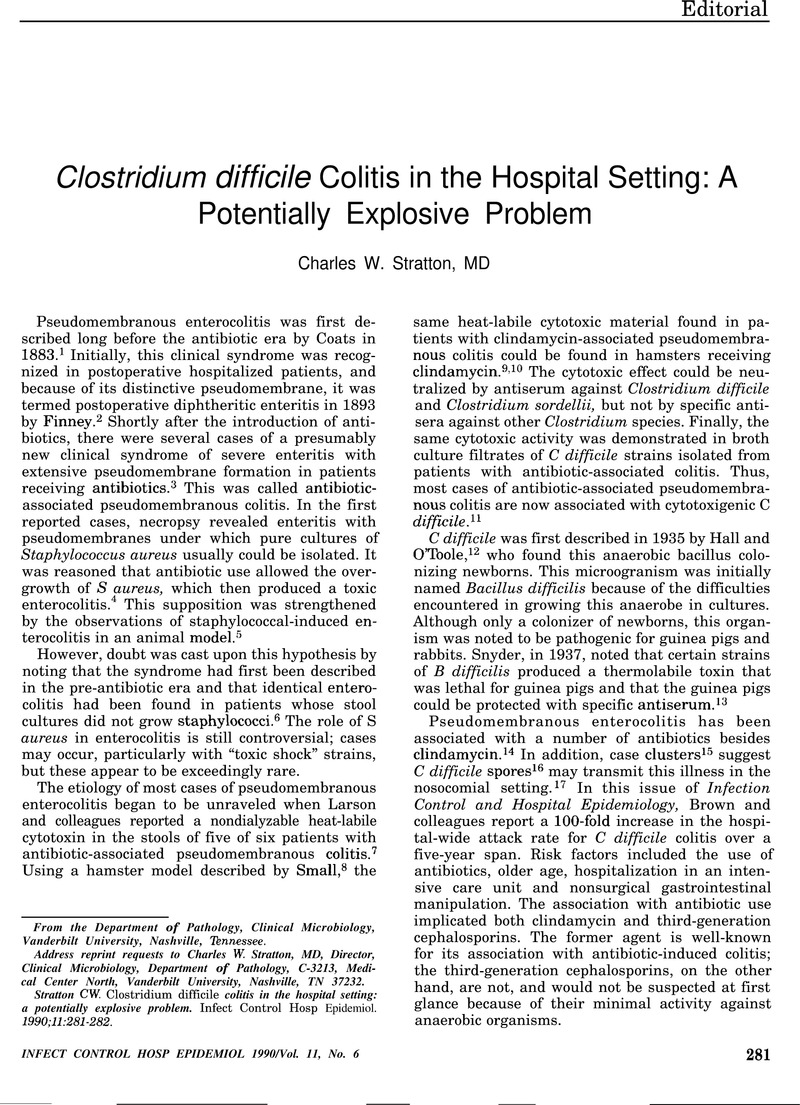No CrossRef data available.
Article contents
Clostridium difficile Colitis in the Hospital Setting: A Potentially Explosive Problem
Published online by Cambridge University Press: 21 June 2016
Abstract
An abstract is not available for this content so a preview has been provided. As you have access to this content, a full PDF is available via the ‘Save PDF’ action button.

- Type
- Editorial
- Information
- Copyright
- Copyright © The Society for Healthcare Epidemiology of America 1990
References
2.
Finney, JMT
Gastroenterostomy for cicatrizing ulcer of the pylorus. Bull Johns Hopkins Hasp. 1893;4:53–54.Google Scholar
3.
Reiner, L, Schlesinger, MJ, Miller, GM. Pseudo-membranous colitis following aureomycin and chloramphenicol. Arch Pathol. 1952;54:39–67.Google Scholar
4.
Dearing, WH, Baggenstoss, AH, Weed, LA. Studies on the relationship of Staphylococcus aureus to pseudomembranous enteritis and to postantibiotic enteritis. Gastroenterology. 1960;38:441–451.CrossRefGoogle ScholarPubMed
5.
Bennett, IL, Wood, JS, Yardley, JH. Staphylococcal psuedomembraneous enterocolitis in chinchillas: a clinico-pathologic study. Trans Assoc Am Physicians. 1956;69:116–121.Google ScholarPubMed
6.
Hardaway, RM, McKay, DG. Pseudomembranous enterocolitis: are antibiotics wholly responsible?
Arch Surg. 1959;78:457–466.Google ScholarPubMed
7.
Larson, HE, Parry, JV, Price, AB, et al.
Undescribed toxin in pseudomembranous colitis. Br Med J. 1977;1:1246–1248.CrossRefGoogle ScholarPubMed
8.
Small, JD. Fatal enterocolitis in hamsters given lincomycin hydrochloride. Laboratory Animal Care. 1968;18:411–420.Google ScholarPubMed
9.
Bartlett, JG, Chang, TW, Gurwith, M, Gorbach, SL, Onderdonk, AB. Antibiotic-associated pseudomembranous colitis due to toxin-producing Clostridia. N Eng J Med. 1978;298:531–534.CrossRefGoogle ScholarPubMed
10.
George, RH. Symonds, JM, Dimock, F, et al.
Identification of Clostridium difficile as a cause of pseudomembranous colitis. Br Med J. 1978;1:695.CrossRefGoogle ScholarPubMed
11.
Bartlett, JG, Chang, TW, Taylor, NS, Onderdonk, AB. Colitis induced by Clostridium difficile
. Reu Infect Dis. 1979;1:370–378.CrossRefGoogle ScholarPubMed
12.
Hall, IC, O'Toole, E. Intestinal flora in new-born infants with a description of a new pathogenic anaerobe, Bacillus difficilis. Am J Dis Child. 1935;49:390–402.CrossRefGoogle Scholar
13.
Snyder, ML. Rirther studies on Bacillus difficilis
. J Infect Dis. 1937;60:223–231.CrossRefGoogle Scholar
14.
Silva, J. Fekety, R, Werk, C, et al.
Inciting and etiologie agents of colitis. Rev Infect Dis. 1984;6(suppl):214–221.CrossRefGoogle Scholar
15.
Kabins, SA. Outbreak of clindamycin-associated colitis. Ann Intern Med. 1975;83:830–831.CrossRefGoogle ScholarPubMed
16.
Kim, KH, Fekety, R, Batts, DH, et al.
Isolation of Clostridium difficile from the environment and contacts of patients with antibiotic-associated colitis. J Infect Dis. 1981;143:42–50.CrossRefGoogle ScholarPubMed
17.
McFarland, LV, Mulligan, M, Kwok, RYY, Stamm, WE. Nosocomial acquisition of Clostridium difficile infection. N Engl J Med. 1989;320:204–210.CrossRefGoogle ScholarPubMed
18.
O'Keefe, JP, Venezio, FR. Divincenzo, CA. Shatzer, KL. Activity of newer ß-lactam. agents against clinical isolates of Bacteroides fragilis and other Bacteroides species. Antimicrob Agents Chemother. 1987;31:2002–2004.CrossRefGoogle Scholar


